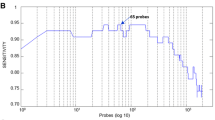Abstract
Microarray analysis and gene expression profile have been widely used in tumor classification, survival analysis and ER statues of breast cancer. Sample discrimination as well as identification of significant genes have been the focus of most previous studies. The aim of this research is to propose a fuzzy model to predict the relapse time of breast cancer by using breast cancer dataset published by van’t Veer. Fuzzy rule mining based on support vector machine has been used in a hybrid method with rule pruning and shown its ability to divide the samples in many subgroups. To handle the existence of uncertainties in linguistic variables and fuzzy sets, the TSK model of Interval type-2 fuzzy logic system has been used and a new simple method is also developed to consider the uncertainties of the rules which have been optimized by genetic algorithm. B632 validation method is applied to estimate the error of the model. The results with 95 % confidence interval show a reasonable accuracy in prediction.












Similar content being viewed by others
References
van’t Veer L, Dai H et al (2002) Gene expression profiling predicts clinical outcome of breast cancer. Nature 415:530–536
Alba E, Garcia-Nieto J et al (2007) Gene selection in cancer classification using PSO/SVM and GA/SVM hybrid algorithms. In: Evolutionary computation. CEC 2007. IEEE congress, 25–28 September, pp 284–290
Bertucci F, Finetti P et al (2004) Gene expression profiling for molecular characterization of inflammatory breast cancer and prediction of response to chemotherapy. Cancer Res 64:8558–8565
Sotiriou C, Neo S et al (2003) Breast cancer classification and prognosis based gene expression profiles from a population-based study. Proc Nat Acad Sci 100(18):10393–10398
West M, Blanchette C et al (2001) Predicting the clinical status of human breast cancer by using gene expression profiles. Proc Nat Acad Sci 98:11462–11467
Gruvberger S, Ringner M et al (2001) Estrogen receptor status in breast cancer is associated with remarkably distinct gene expression patterns. Cancer Res 61:5979–5984
Sorlie T, Perou CM et al (2001) Gene expression patterns of breast carcinomas distinguish tumor subclasses with clinical implications. Proc Nat Acad Sci 98:10869–10874
Takahashi H, Masuda K et al (2004) Prognostic prediction with multiple fuzzy neural models using expression profiles from DNA microarray for metastasis of breast cancer. J Biosci Bioeng 98(3):193–199
Li F, Yang Y (2005) Analysis of recursive gene selection approaches from micro-array data. Bioinformatics 21:3741–3747
Jiang D, Zhao N (2006) A clinical prognostic prediction of lymph node-negative breast cancer by gene expression profiles. J Cancer Res Clin Oncol 132:579–587
Alexe G, Alexe S et al (2005) Breast cancer prognosis by combinatorial analysis of gene expression data. Breast Cancer Res 8(4):R41
Shen R, Ghosh D et al (2006) Eigengene-based linear discriminant model for tumor classification using gene expression microarray data. Bioinformatics 22(21):2635–2642
Mahmoodian H, Hamiruce Marhaban M, Abdulrahim R, Rosli R, Saripan I (2011) Using fuzzy association rule mining in cancer classification. Australas Phys Eng Sci Med 34(1):41–54
Gruvberger S, Eden P et al (2004) Predicting continuous values of prognostic markers in breast cancer from microarray gene expression profiles. Mol Cancer Ther 3:161–168; 61:5979–5984
Zade L (1976) A fuzzy-algorithm approach to the definition of complex or imprecise concepts. Int J Man–Mach Stud 8:249–291
Quinlan R (1993) C4.5: programs for machine learning. Morgan Kaufman, San Francisco
Pal K, Mitra S (1999) Neuro-fuzzy pattern recognition: methods in soft computing. Wiley series on intelligent systems. Wiley-Interscience, New York
Kouk C, Fu A et al (1998) Mining fuzzy association rules in data base. SIGMOD 27:41–46
Chen S, Wang J et al (2008) Extraction of fuzzy rules by using support vector machines. In: Fifth international conference on fuzzy systems and knowledge discovery
Farquad M, Ravi V et al (2008) Rule extraction using support vector machine based hybrid classifier. In: IEEE region 10 conference, November.
Jain R, Abraham A (2004) A comparative study of fuzzy classification methods on breast cancer data. Australas Phys Eng Sci Med 27(4):213–218
Guyon I, Weston J et al (2002) Gene selection for cancer classification using support vector machines. Mach Learn 46:389–422
Mendel J (2007) Type-2 fuzzy sets and systems: an overview. IEEE Computational Intelligence Magazine, February
Karnik N, Mendel J et al (1999) Type-2 fuzzy logic systems. IEEE Trans Fuzzy Syst 7(6):643–658
Castillo O, Melin P (2008) Type-2 fuzzy logic: theory and applications. Studies in fuzziness and soft computing, vol 223. Springer, Berlin
Karnik N, Mendel J et al (2001) Centroid of a type-2 fuzzy set. Inf Sci 132:195–220
Mendel J (2001) Uncertain rule-based fuzzy logic systems: introduction and new directions. Prentice Hall, Upper Saddle River
Ishibuchi H, Yamamoto T (2005) Rule weight specification in fuzzy rule-based classification systems. IEEE Trans Fuzzy Syst 13(4):428–435
Vaníček J, Vrana I et al (2009) Fuzzy aggregation and averaging for group decision making: a generalization and survey. Knowl-Based Syst 22:79–84
Yen J, Wang L et al (1998) Improving the interpretability of TSK fuzzy models by combining global and local learning. IEEE Trans Fuzzy Syst 6(4):530–537
Efron B (1983) Estimating the error rate of a prediction rule: improvement on cross validation. J Am Statist Assoc 78:316–331
Efron B, Tibshirani R (1997) Improvement on cross-validation: the.632+ bootstrap method. J Am Statist Assoc 92:548–560
Author information
Authors and Affiliations
Corresponding author
Rights and permissions
About this article
Cite this article
Mahmoodian, H. Predicting the continuous values of breast cancer relapse time by type-2 fuzzy logic system. Australas Phys Eng Sci Med 35, 193–204 (2012). https://doi.org/10.1007/s13246-012-0147-z
Received:
Accepted:
Published:
Issue Date:
DOI: https://doi.org/10.1007/s13246-012-0147-z




